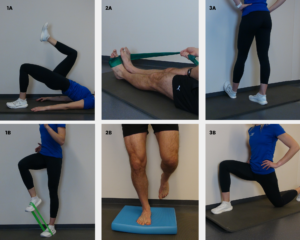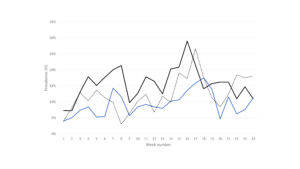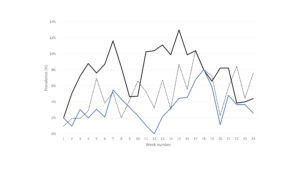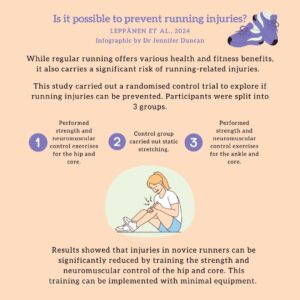Keywords: running, running-related injuries, injury prevention
This blog summarises a recently published study exploring the prevention of running-related injuries (1).
Running is a widely enjoyed recreational physical activity across numerous countries. While regular running offers various health and fitness benefits (2), it also carries a significant risk of running-related injuries (3). Running-related injuries are highly common especially in novice runners (3-4). In this blog we will introduce an effective exercise programme to prevent injuries in novice runners. Our recently published study was conducted in Finland in collaboration with the University of Calgary and Norwegian School of Sport Sciences.
Why is this study important?
Many novice runners stop running because of injuries, which leads to loss of health benefits of regular running. Finding effective methods to reduce the number and severity of running-related injuries is important to keep novice runners participating in regular running.
Previous studies on exercise-based injury prevention in novice recreational runners are rare, and the overall evidence is still very limited. Theories on how running-related injuries can be prevented have been introduced, but these theories have seldom been tested in controlled studies. In biomechanics and injury prevention, “top-down” and “bottom-up” theories represent different approaches to understanding how the body moves and how injuries occur and can be prevented.
According to the “top-down” theory, strong core and hip muscles can help maintain pelvic and lower extremity stability during activities and reduce stress on the joints (5). On the contrary, the “bottom-up” theory suggests that strong ankle and foot muscles can provide a solid foundation and stability for all movements and reduce the risk of injuries (6). Limited number of studies have investigated these theories. Therefore, our study aimed to find out if one or both of these aforementioned theories would show true preventive effects in novice recreational runners.
How did the study go about this?
We invited novice recreational runners to participate in a study, which we conducted in Tampere, Finland. The participants were healthy adults aged 18–55 years with less than two years of regular running experience. The participants attended running training groups led by a physiotherapist twice a week for six months.
Before the study began, the 325 volunteers were randomly divided into three training groups, two intervention groups and one control group. One intervention group performed strength and neuromuscular control exercises for the hip and core. Another intervention group did exercises to improve the muscle strength and neuromuscular control of the ankle and foot. The third group was a control group, which did static stretching.

Figure 1: Examples of hip and core (A, B), ankle and foot (C, D) and control group (E, F)
The groups carried out the training programme twice a week for 20-35 minutes. The exercises and difficulty level progressed over the course of the study. Each exercise had four different versions with different levels of difficulty and intensity. After each training session, the groups moved outdoors and completed their running training session, which lasted 30–75 minutes. All groups followed a similar running training programme and the basics of running technique were taught to all groups in the same way. Participants reported all running-related injuries each study week using a mobile application.
What did the study find?
Our study found that the group focusing on hip and core training sustained less running-related lower extremity injuries than the control group performing static stretching. Hip and core focused training was especially effective to reduce running-related overuse injuries as this group had 39% lower prevalence of all overuse injuries and 52% lower prevalence of substantial overuse injuries compared with the control group.

Figure 4. Prevalence of lower extremity (LE) overuse injuries in hip and core group (blue line), ankle and foot group (dashed black line), and control (black line) group during the 24 week study.

Figure 5. Prevalence of substantial lower extremity (LE) overuse injuries in hip and core group (blue line), ankle and foot group (dashed black line), and control (black line) group during the 24-week study.
The ankle and foot exercise programme did not prevent running-related injuries compared to stretching. The incidence of acute injuries was lower in the stretching group than in the ankle and foot exercise group, suggesting that stretching might be beneficial in preventing acute muscle injuries in running.
What are the key take-home points?
This study demonstrated that injuries in novice runners can be significantly reduced by training the strength and neuromuscular control of the hip and core areas. The prevalence of overuse injuries was cut by about half with this training compared to stretching, which has traditionally been thought to prevent injuries. This training can be implemented with minimal equipment, using only resistance bands and body weight for resistance.
An interesting finding was that stretching appeared to be effective in preventing acute muscle injuries. However, since there were a low number of acute injuries in the study, this observation should be approached with caution. Given that the majority of running injuries are overuse-related, hip and core focused strength and neuromuscular training is superior to stretching as a method for preventing injuries in novice runners.

The exercise programmes used in the study can be found from our study’s YouTube channel: https://www.youtube.com/@TheRUNRCTStudy/playlists
Hip and core programme can also be downloaded from our web page: https://terveurheilija.fi/wp-content/uploads/2024/06/TheRunRCTHipAndCoreProgram.pdf
References:
- Leppänen M, Viiala J, Kaikkonen P, et al. Hip and core exercise programme prevents running-related overuse injuries in adult novice recreational runners: a three-arm randomised controlled trial (Run RCT). British Journal of Sports Medicine 2024;58:722-732.
- Hespanhol Junior LC, Pillay JD, van Mechelen W, et al. Meta-analyses of the effects of habitual running on indices of health in physically inactive adults. Sports Med 2015;45:1455–68.
- Videbæk S, Bueno AM, Nielsen RO, et al. Incidence of running-related injuries per 1000 H of running in different types of runners: a systematic review and meta-analysis. Sports Med 2015;45:1017–26.
- Linton L, Valentin S. Running with injury: a study of UK novice and recreational runners and factors associated with running related injury. J Sci Med Sport 2018;21:1221–5.
- Powers CM. The influence of abnormal hip mechanics on knee injury: a biomechanical perspective. J Orthop Sports Phys Ther 2010;40:42–51.
- Nigg BM, Baltich J, Federolf P, et al. Functional relevance of the small muscles crossing the ankle joint – the bottom-up approach. CISS 2017;2:1–6.
Authors and affiliations:
Dr. Mari Leppänen, Tampere Research Center of Sports Medicine, UKK Institute, Tampere, Finland.
Dr. Kati Pasanen, Faculty of Kinesiology, University of Calgary, Calgary, Alberta, Canada.